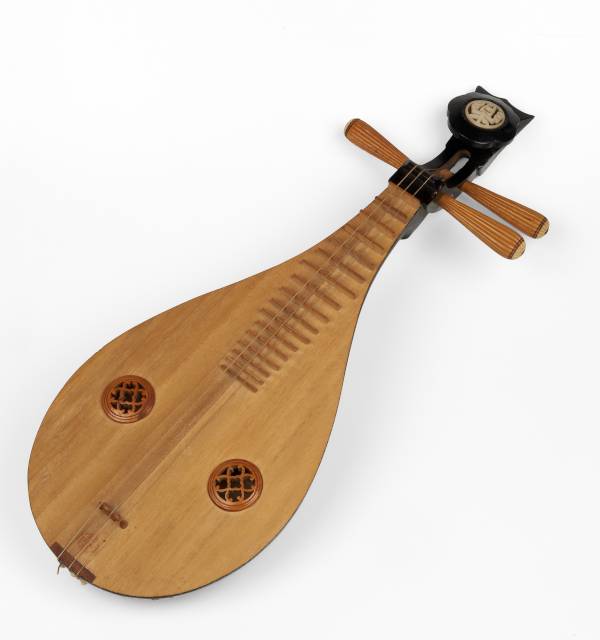

In addition, most yueqin do not have the obvious double soundholes, like the ruan, instead they have the single small soundhole located under where the strings are attached (also similar to pipa). While both instruments have a moon-shaped soundboard, the modern ruan uses a bridge, whereas the yueqin simply attaches the strings the frame, similar to the design of the pipa. Modern yueqin are often played with a guitar pick. In Beijing opera, the player uses a small wooden dowel instead of a plectrum to perform, and only plays in first position this requires the performer to use octave displacement in order to play all the pitches within a given melody.


The nut, at the peghead end of the instrument, is filed with notches appropriate to the number and position of the strings.

The anchor on a modern yueqin may have up to five holes, so it can be strung and tuned as a three or four-stringed instrument. The strings on the traditional form of the instrument were made of silk, though nylon is generally used today. In Taiwan, the yueqin has a longer neck, and two or three strings. Yueqin used for Beijing opera have two strings, only one of which is actually used, the lower string being there purely for sympathetic resonance. Most yueqin have four strings, although others have two or three. Modern yueqin have frets tuned in semitones. The frets were formerly arranged rather like those on a mountain dulcimer, so that the instrument is diatonic however, the fret size is high enough that any pitch may be bent up a minor 3rd. This allows for a greater control over timbre and intonation than their western counterparts, but makes chordal playing more difficult. Frets on all Chinese lutes are high so that the fingers never touch the actual body-distinctively different from western fretted instruments. Occasionally, the body of the yueqin may be octagonal in shape. The yueqin typically has a round soundboard with no sound-hole, but inside the sound box are one or more strands of wire attached only at one end, so that they vibrate, giving the instrument a particular timbre and resonance. The name yueqin once applied to all instruments with a moon-shaped soundboard, including the ruan however, "yueqin" now applies to a separate category from the ruan family.Ī yueqin in the Queensland Museum Soundboard The ruan, another Chinese instrument, is the ancestor of the yueqin. The instrument was invented in China in the 3rd to 5th centuries AD, during the Jin dynasty. It is an important instrument in the Peking opera orchestra, often taking the role of main melodic instrument in lieu of the bowed string section. It is a lute with a round, hollow soundboard, a short fretted neck, and usually four strings. The yueqin ( Chinese: 月琴 pinyin: Yuèqín Japanese: 月琴, romanized: Gekkin Korean: 월금/月琴, romanized: Wolgeum Vietnamese: Nguyệt cầm or Vietnamese: Đàn nguyệt), also called a moon lute or moon guitar, is a traditional Chinese string instrument. The instrument comes in a variety of sizes and pitches.


 0 kommentar(er)
0 kommentar(er)
